glabrous pigs
of
vanuatu
The Glabrous Pigs of Vanuatu
Previously unstudied populations of glabrous(hairless) and dwarf pigs were identified and documented on the island of Tanna in the Republic of Vanuatu in the Southwest Pacific
jJames K McIntyre
Southwest Pacific Research Project
jmcintyre@swprp.org
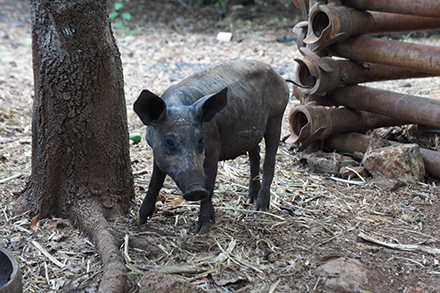
Abstract
Hairless pigs on Tanna are culturally significant and, according to custom law, can only be exchanged during two specific occasions. The dwarf pigs appear to have no traditional value and are recognized because of their anomaly.
A preliminary investigation yielded isolated animals exhibiting the before mentioned conditions. Morphological descriptions, tissue, hair, hair root ball, and blood samples were collected from ten hairless, six dwarf, and six "normal" pigs. The hairless pigs are said to be slower growers and behaviorally have a calmer disposition than their wild island counterparts (normal pigs). Some hairless pigs possess dry scaly skin which is believed to be diet related. The degree of hairlessness was graded on a scale of one to ten(one being totally void of hair ). This particular type of hairlessness appears to be as a result of a recessive trait, but a further investigation is warranted.
A Glabrous Pig like the ones studied by the author

Introduction
Vanuatu, (formerly the New Hebrides), is a Y-shaped archipelago of eighty islands located in the southwest Pacific between latitude 12 deg. and 20 deg. and longitude 166 deg. and 171 deg.( See figure 1) It’s distance from north to south covers 1000 km. All of the islands, to some extent, have been affected by volcanic activity, which has fashioned Vanuatu’s islands in the geological past, and helped to re-shape some in the recent present. Vanuatu’s vegetation is generally described as tropical rainforest. On many islands, the forest extends from the high mountain interior to the coastlines and it’s it’s density makes much of it’s interior virtually impenetrable. Tanna, one of Vanuatu’s more remarkable and diverse islands, lies at the southern end of the island chain. It is 40 km long by 27 km wide. It’s 565 sq km is a compact mix of savannah, thick brush and rugged mountains. In the center is a fertile area known as the Middle Bush by islanders. In 1774, Captain James Cook landed in a small bay at the southern end of the island, drawn to this area by the nighttime glow of Tanna’s active volcano, Mt. Yasur. Tanna is rich in natural history and resources. Traditional life is still evident with 85% of it’s population living in small villages and surviving on subsistence gardening. Tanna boasts Cargo cult followers, age old festivals and ceremonies, free roaming wild horses, spouting blowholes, hot springs, and the world’s most accessible active volcano, Yasur.
A Glabrous Pig like the ones studied by the author
Origin of Pigs in the Pacific
Pigs have been woven into the fabric of Pacific island lifestyles for thousands of years. Most historians agree that the peoples of the Western pacific originated in Southeast Asia about 40,000 years ago, and through a series of migrations across Indonesia and the New Guinea chain, colonized many islands, including the Solomons and Vanuatu beginning about 3000 BC. (Harcombe, 1991). Douglas (1990) claims that in about 1400 BC, the protomelanesians (people of the Lapita culture) traveled by canoe and brought with them yams, taro and the predecessor of the native pig. The Southwest Pacific pigs, Sus sp., are incorrectly referred to as Sus papuensis by some scientists. These pigs are actually S. scrofa vittatus X S. celebensis hybrids.( Groves,1981; Oliver,1993)
Subsequent breedings with domestic pigs, shape today’s Pacific island pig. McIntyre wrote in 1997, “The indigenous pig, still thriving today, seems to have adapted extremely well to the climatic and geographical conditions of Vanuatu. These pigs can be found on almost every island in Vanuatu in both it’s wild and domesticated states. The predominant characteristics of these pigs are hardiness, compact size and long tapering snouts. Much smaller than their Eurasian counterparts, Sus scrofa, the adult boar will generally weigh no more than 100kgs.” The Vanuatu Sus sp. has a leaner body build than the commercial high production varieties which have proven uneconomical in this humid tropical environment.
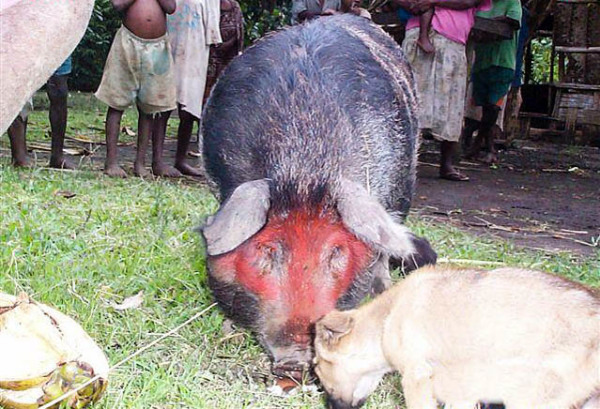
A Glabrous Pig with face stained red in a pattern symbolic of the chief
According to Weightman(1989), Paddon probably brought the first European breed of pig when, in 1845, he brought many kinds of livestock from Australia to The Vanuatu island of Aneityum. Captain Cook, along with subsequent explorers, added to and hybridized the original pig populations with their European breeds.Pigs were not only used for food, but more often as money and a symbol of one’s wealth. The more pigs a man owned, the wealthier he was. Pigs were bred, bought, sold, and traded. Pigs were even exchanged for brides at weddings in payment of the bride price. Pigs were generally only eaten during special ceremonies and rarely ever as a commonplace daily occurrence. In some of the central and northern islands of Vanuatu, any man can become chief, through a system of grade-taking or “Nimangki”. Possessing large amounts of pigs was important. Castrated male pigs, with circular tusks were more valuable. Hermaphrodite {more correctly termed Intersexual( McIntyre, 1997 )} pigs were worth their weight in gold. On some of the more southern islands, Tanna in particular, chiefdom is hereditary, but pigs are no less important. On Tanna, the hairless pigs(Or Kapia, Kepwia, Kepwiah, Pukah Kipwia, pig as they referred to by the Tannese men)( Huffman, 2000)are the most valued form of Tannese pig (Bonnemaison, Huffman, 1996). Perhaps, because of it’s rarity, does the Kapia pig get it’s value.
Lore and Legend

Kapia pigs, have been in the past and continue to be today, a very rare occurrence on the island of Tanna. The only other island these pigs are said to have occurred is on Futuna (Tanna’s island neighbor to the east) as a result of inter-island trading. Each island of the Vanuatu archipelago is culturally diverse from the next. It is a fact, that as important as these hairless pigs are to the chiefs of Tanna, they are all but unheard of on the northern islands. In the same respect, When the author spoke of the Intersexual pigs (McIntyre, 1997), revered culturally in the north, the people of Tanna had never heard of such an animal.
As told to me by Chief Tom Numake( 2000), President, Tanna Council of Chiefs, “Kapia pigs are the pigs of the chiefs only, but today are sometimes ritually killed during circumcision ceremonies, weddings, and bride price offerings, which he remarks is culturally incorrect. According to Custom law, there are only two instances when the Kapia may be exchanged and eaten.( and this is only between chiefs)These are at certain times of the year in exchange for a sea turtle and as a gratitude payback from Toka dancers one month after the Nekowair ceremony.”Guiart mentions hairless pigs as a status symbol in his (1956) publication. He goes mon to say, “Everyone has the right to eat the flesh of this animal, but only certain dignitaries maintain the privilege of organizing the cooking of hairless pigs, or at least supervising this.”
Glabrous Pigs play an important role in Vanuatu culture
There are five classes of people on Tanna. The highest class are the Rulers (Lords), or the Yeremuru(Iermanu).. The next two classes are the high chiefs and the chiefs (Spokesman of the canoe)( Lindstrom 2000). These men are referred to as Yenni(Iani neteta). Each locale has at least one of these titles-and some more. The next class of man is the Tapunis man and the last is the common man. The Tapunis men are very important because they are the “ providers” for all of the people’s needs. These men claim rights to various types of magic. There are Tapunis men for fish, bananas, fruits, vegetables, chickens, and a Tapunis Kapia pig man. With a sacred herb , worked together, and rubbed on a special stone, the Tapunis Kapia man is said to be able to create more Kapia pigs when their numbers get low. During certain times of the year word comes down to the coast, via the custom network that the people in the highlands want some sea turtles.
There are special Tapunis turtle men on the coast who have the power (with th e use of special herbs and stones) to attract sea turtles to the coast. The Tapunis turtle men must not sleep with women or eat certain foods during the time (2 or 3 months) they are attracting the turtles into a cove.
When the turtles approach the shoreline, sharks are requested, by the use of more herbs and special stones, to swim back and forth, blocking the sea turtle’s exit back out into the sea. The specific numbers of sea turtles are selected. At this point the sharks discontinue their blockade and allow the remaining turtles to swim back out to sea. These sea turtles are now exchanged with the highland people for kava, taro, and a Kapia pig. Upon the swap, the Kapia pigs’ snout and forehead is stained (with the reddish-orange pulp, around the nut of a local plant) in a pattern representing that of the offering highland chief. The Kapia pigs are then cooked and shared with the people of the coastal village.

Sea Turtles also play an important role in Vanuatu culture
Chief Tom mentioned that Kapia pigs are only eaten during the months of March through August.( These months correspond with those months the sea turtles can be captured.) The only other time a Kapia Pig can be exchanged is one month after a Nekowiar Festival. This festival occurs about every two years or so on Tanna and brings remote villages together (to renew clan alliances, with exchanges of gifts in the form of song, dance, food, etc.) The villages celebrate enduring exchange relations between places and lineages. This four day ceremony culminates in a massive, all male Toka dance that can last all night. On the afternoon of the next day, a large number of pigs are killed by the host villages and presented to the guest dancers. One month later, the Toka dancers repay this generous gift with an equal number of pigs of their own - plus 10 or 20 more. One of these pigs will be a Kapia pig with its face stained red in a pattern symbolic of the chief making the offering. ”Such a pig is a beautiful sight to see, with its face painted red, like a “chief” as it is led across the dancing ground in presentation rituals from bigman (Chief) to bigman.” ( Bonnemaison, J., Huffman, K., et al.)
Investigations/Materials & Methods
During July of 2000, The Southwest Pacific Research Foundation traveled to Vanuatu in the South Pacific, to investigate the incidence of glabrousness(hairless condition) on some of the southern islands of the Vanuatu island chain. Along with a student research assistant, a two-fold field study was undertaken to investigate these mammalian anomalies from a scientific standpoint and at the same time document their cultural significance to the people of Tanna.
I enlisted the assistance of Chief, Tom Numake to help us identify and locate the rarely occurring Kapia pigs. Chief Tom, besides being current President of the Tanna Council of Chiefs, and one of the authors of the original written version of Tanna’s Custom Law, ardently fights to preserve the customs and traditions of his father and grandfather. He is respected and influential on the island of Tanna and has, or can get, access to the peoples of even the remotest bush villages. Chief Numake, being the author’s only contact on Tanna, was probably the best contact anyone would need to explore remote areas of Tanna island.. By the time the author’s field team touched down at the airport on Tanna, Chief Tom had located ten villages which were thought to contain Kapia pigs.
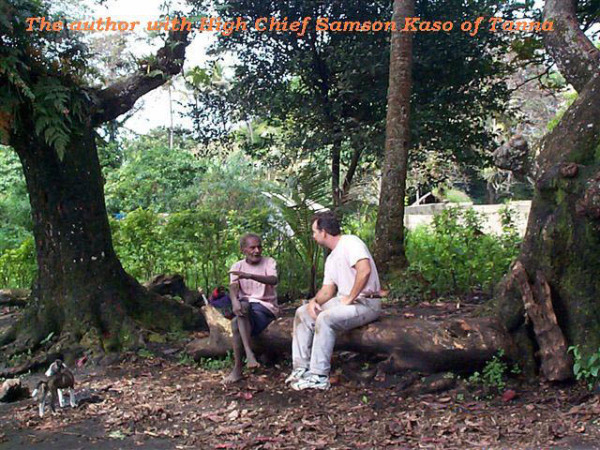
The author, James McIntyre, shown here with Chief Samson of Kaso of Tanna
These villages were located in all corners of Tanna, as well as the central Middle Bush. Many village visits required a one and a half hour truck ride on “roads” that were more representative of a bad path, immediately followed by a one hour bush walk and climb, to examine perhaps one pig. In all, ten Kapia pigs were located, investigated, and documented. Each pig was photographed and videotaped. Approximate age and weights, as well as descriptions were noted.( See table 1) Each pig was manually restrained while blood, tissue, and hair samples were collected from the top side ear. The tissue and hair samples were collected in a 70% ethyl alcohol solution. Blood samples were collected on Fitzco/Whatman FTA Classic Cards and allowed to air dry. Each animal was ear tagged in the hole left by the tissue sample. Each pig owner was in turn offered a gift of five kilos of rice and two cans of tin fish for allowing us the examine their prized possessions. Results; Descriptions of the Kapia and Pissis Pigs KAPIA PIGS Tanna’s hairless pig, at first sighting, is indeed a strange sight.
Ten of the ten pigs we investigated were predominately black in color, which resulted from the black pigment in their skin, as there was no hair to influence the color or pattern. Their skin was very dry and scaley in appearance. It was also noted that many of the villagers had the same condition with their skin which perhaps points to a diet related condition, since pig and human diet is roughly the same (Lindstrom, 2000). Heavy Kava drinking (a traditional drink made from the roots of the Piper methistycum plant) has also been known to dry out the skin.
There was relatively no hair to speak of on the entire torso of these animals. Each pigs was graded on a scale of 1 to 10. (1 being completely hairless and 10 being normally haired.) Nine of the ten pigs fell between 1 and 3, with one pig graded a 4 as a result of additional hair around the jowls and ears. What little hair that was evident, was usually sparsely distributed down the center of the back.
There was no set skull or body shape characteristic of the Kapia pig. Pigs with long, narrow snouts and taller, leaner torsos were observed as well as the more "European” skull and body types (ie: shorter snout length and stockier body type). One hairless pig was observed to be “dwarfish” in appearance (see following section on Pissis pigs) as compared to the others.
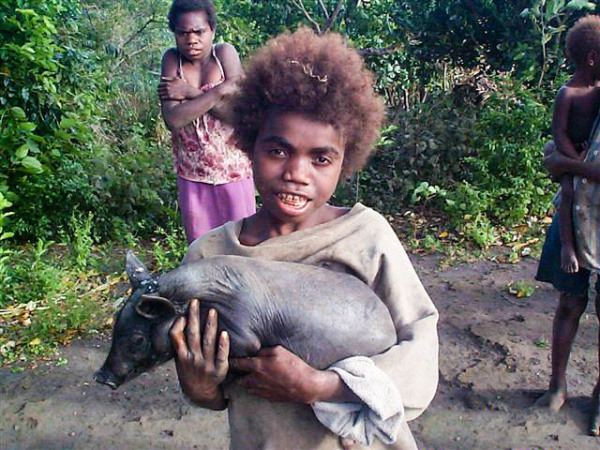
A Tanna friend presents a glabrous pig to the author for a photo
I did not observe any extra care and maintenance given to these pigs, which was much different from the intensive care given to the raising of the Intersexual pigs on the Northern islands.(McIntyre,1997) More often than not, the Kapia pigs ran free in the bush with all of the other village and wild pigs. When we asked to study these pigs, they had to be hunted down and captured using the adept skills of the village pig hunting “catch” dogs. There are also people that are referred to as “Kapia men.” Living on Tanna today are adult men with hair on their heads, but the remainder of their body is virtually devoid of hair. This includes facial, arms, legs, chests, and genital area.(Numake,2000) PISPIS PIGS PisPis pigs(The local name given to this particular type of pig) were also observed and documented during this study. Describing this pig is a little less definitive than that of the Kapia pig. PisPis pigs, even when mature, are somewhat “dwarfish” in appearance. Characteristics that we found in common with the 6 specimens observed were and abbreviated shortened snout and the appearance of shorter than normal legs. A stocky body shape was also characteristic of the PisPis pig. Although no obvious cultural or traditional importance is placed on these pigs, they are, nonetheless, still maintained and identified as such.
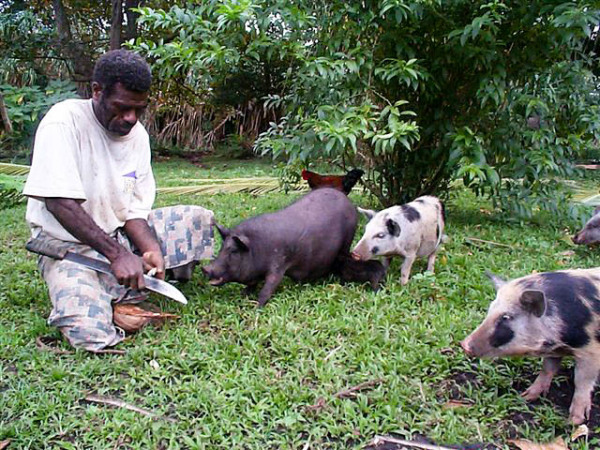
Breeding and Genetics
The average farrow size of Tanna’s pigs seems to fall between four to six piglets per litter. If there is a Kapia pig represented in the breeding pair,(ie: either sow or boar) the chances of the pair producing another Kapia pig( one Kapia piglet every three or four farrows or approximately 6%of the offspring) ) are better than if neither parent is phenotypically Kapia.. Kapia pigs have occasionally produced by “non-Kapia” looking parents. The Kapia condition is more than likely a recessive trait. We learned that the percentages of Kapia offspring are even greater if both in the breeding pair are Kapia type pigs. The Kapia pigs of Tanna, in comparison to “normal” pigs, are said to be slower in their growth, although they do eventually grow to an average adult weight of “normal pigs, 80 to 90 kgs.))The Kapia pigs are said to be somewhat “slack” in their behavior, referring to their less aggressive behaviors and their willingness to stay in and around the villages while their normal counterparts readily take to the bush.
A Tanna resident with glabrous pigs

Abstract Closing Recommendations
It is with hopes, that this preliminary investigation shed some light on this condition of hairlessness on a small group of the pig population on the island of Tanna, and nowhere else in the world. Perhaps the genes or enzyme deficiencies responsible for this condition can be isolated and this information applied to other studies in this area. Expanding this study to include genomic analysis and dietary studies is mandatory if the secrets of this hairless condition are to be identified. Comparing these results with those generated from other populations of hairless pigs will aid in a better understanding of porcine glabrousness. Of equal importance is the anthropological information being documented and thus preserved for a people whose custom ways are rapidly disintegrating. It is with hopes by studying these unique animals, and recording these findings, that future generations might know the importance the Kapia pig played in the lives of their forefathers.
A Glabrous Pig like the ones studied by the author
Acknowledgements
First, and most importantly, I would like to thank Chief Tom Numake for his invaluable contributions to the ultimate success of this project. Besides arranging the excellent accommodations and meals for our study team, Chief Numake worked diligently, prior to our arrival, locating Kapia and PisPis pigs for investigation. Many thanks to the competent and friendly staff at Tanna Evergreen Bungalows for making our stay on Tanna comfortable and worry free. Thank you Miriam, Peter, Sam, and Samuel. To our Guide, Louie, Thanks for your competent assistance. To our drivers, Sam, and George, thanks for getting us to places no vehicles were ever meant to go. And to those pig owners who shared prized possessions and stories with us, Thank you Chief Samsom Kaso, Chief Jack Naiva, Charlie Noklam, Semil, Yabilai Johnson, Capera, Kubulu Moses, Mrs. Kakau, Munbasena, Yoda Root, Reuben Kamedi, Peter Sia, Noka, and George. Gratitude to EIEICO, Inc. of Pennsylvania, USA, and Templar Sciences for generously funding this study. Special thanks to Anthropologists, Kirk Huffman and Dr, Lamont Lindstrom, for their expertise, and critique of this paper. And To my son, Tucker Samuel McIntyre, for being a more than competent assistant and a great travel partner.
Bibliography